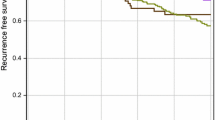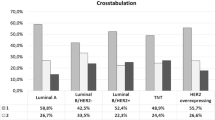Abstract
Background
Breast cancer is a clinically heterogeneous disease. Approximately 10–15 % of breast cancer patients develop distant metastases within 2 years of diagnosis with a poor 5-year survival rate of 21 %. Little data have been gathered about how some breast cancer metastasizes earlier than expected. The study aimed to identify predictors of distant metastases among breast cancer patients in relation to their clinical and tumour characteristics. The results of the study may have important implications in our understanding of the disease process allowing more aggressive treatment and monitoring of certain subgroups of patients.
Methodology
Retrospective review of 215 patients (54 % early stage and 46 % locally advanced stage) who fulfilled the specified criteria was performed. Twelve variables were considered. Univariate and multivariate logistic regression analyses were performed to identify independent predictors of developing distant metastasis within 24 months after surgery and adjuvant therapy.
Results
Of the 215 patients, 27.9 and 17.7 % developed bone and visceral metastasis, respectively. Bone metastasis was significantly dependent on stage, tumour size, lymph node involvement, lymphovascular invasion, estrogen receptor, progesterone receptor and Her/2-neu pattern (p < 0.05). Visceral metastasis was significantly dependent on age, menopausal status, stage, tumour size, lymph node involvement, estrogen receptor, progesterone receptor and Her-2/neu pattern (p < 0.05). Among patients with bone and visceral metastases, 67 and 43 % have triple negative pattern, respectively. Logistic regression provided an accurate model for predicting bone but not visceral metastasis.
Conclusion
A significant fraction of breast cancer patients experienced early metastasis. Our data suggest that tumour stage, size and lymph node involvement are major predictors of metastasis. Her-2/neu over-expression alone is not a strong predictor of early metastasis but triple negative breast cancers belong to an aggressive subgroup with early metastatic capacity. Young, premenopausal patients may benefit from aggressive surveillance and treatment since they tend to present with early visceral spread.
Similar content being viewed by others
References
American Joint Committee on Cancer Staging Manual, 7th, Edge SB, Byrd DR, Compton CC, et al (Eds) (2010) S. Giordano. Update on Locally Advanced Breast Cancer. Springer, New York
Cardoso F, Fallowfield L, Costa A, Castiglione M, Senkus E (2011) Locally recurrent or metastatic breast cancer: ESMO clinical practice guidelines for diagnosis treatment and follow-up. Annal Oncol 22(suppl 6):vi25–vi30
Carlson R, Craig A, Anderson B, Burstein H, Carter WB, Edge S, Erban J et al (2012) Breast cancer. National Comprehensive Cancer Network (NCCN) Clinical Practice Guidelines in Oncology 7:122–129
Cianfrocca M, Goldstein LJ (2004) Prognostic and predictive factors in early stage breast cancer. Oncologist 9(6):606–616
Clark GM, Sledge GW, Osborne CK, McGuire WL (1987) Survival from first recurrence: relative importance of prognostic factors in 1,015 breast cancer patients. J Clin Oncol 5(1):55–61
Coleman RE, Smith P, Rubens RD (1998) Clinical course and prognostic factors following bone recurrence from breast cancer. Brit J Cancer 77(2):336–340
De Vita V, Lawrence T, Rosenberg S. De Vita (2008) Hellman and rosenberg’s cancer: principles and practice of oncology, 8th Ed.
Diel IJ, Solomayer EF, Costa SD, Gollan C, Goerner R, Wallwiener D, Kauffmann M, Bastert G (1998) Reduction in new metastases in breast cancer with adjuvant clodronate treatment. N Engl J Med 339(6):357–363
El Saghir NS, Adebamowo CA, Anderson BO, Carlson RW, Bird PA, Corbex M, Badwe RA, Bushnaq MA (2011) Breast cancer management in low resource countries (LRCs): consensus statement from the breast health global initiative. The Breast 20:S3–S11
Gajdos C, Tartter PI, Bleiweiss IJ (1999) Lymphatic invasion, tumor size, and age are independent predictors of axillary lymph node metastases in women with T1 breast cancers. Ann Surg 230:692–696
Gennari A, Conte P, Rosso R, Orlandini C, Bruzzi P (2005) Survival of metastatic breast carcinoma patients over a 20-year period: a retrospective analysis based on individual patient data from six consecutive studies. Cancer 104(8):1742
Giordano SH (2003) Update on locally advanced breast cancer. Oncologist 8:521
Gluck S (2007) Importance of distant metastasis and its impact on survival rates on early stage hormone receptor positive breast cancer. US Oncol Dis 1(1):22–25
Jensen A, Jacobsen J, Norgaard M, Yong M, Fryzek J, Sorensen H (2011) Incidence of bone metastases and skeletal-related events in breast cancer patients: a population-based cohort study in Denmark. BioMed Cent 11:29
Kuru B, Camlibel M, Dinc S, Gulcelik MA, Gonollu D, Alagol H (2008) Prognostic factors for survival in breast cancer patients who developed distant metastasis subsequent to definitive surgery. Singap Med J 49(11):904
Ngelangel CA, Wang EHM (2002) Cancer in the Philippine Cancer Control Program Japanese. J Clin Oncol 32(suppl 1):S52–S61
Ossovskaya V, Wang Y, Budoff A, Xu Q, Lituev A, Potapova O, Vansant G, Monforte J, Darasella N (2011) Exploring molecular pathways of triple negative breast cancer. Genes Cancer 2(9):870–879
Popoola AO, Ibrahim NA, Omodele FO, Oludara MA, Adebowale SA, Igwilo AI (2012) Pattern of spread of breast cancer among patients attending cancer unit of Lagos State University Teaching Hospital. Asian J Med Sci 4(3):89–94
Rabinovitch R, Kavanagh B (2009) Double helix of breast cancer therapy: intertwining the Halsted and Fisher Hypotheses. J Clin Oncol. Vol. 27. No. 15
Sihto H, Lundin J, Lundin M, Lehtimaki T, Ristimaki A, Holli K, Sallas L, Kataja et al (2011) Breast cancer biological subtypes and protein expression predict for the preferential distant metastasis: a nationwide cohort. Breast Cancer Res 13:R87
Solomayer EF, Diel JJ, Meyberg GC, Gollan C, Basterg G (2000) Metastatic breast cancer: clinical course, prognosis and therapy related to the first site of metastasis. Breast Cancer Res Treat 59(3):271–278
Yau C, Esserman L, Moore DH, Waldman F, Sninsky J, Benz CC (2010) Multigene predictor of metastatic outcome in early stage hormone receptor negative and triple negative breast cancer. Breast Cancer Res 12(5):R85
Conflict of interest
We certify that there is no conflict of interest with any financial organization regarding the material discussed in the manuscript.
Author information
Authors and Affiliations
Corresponding author
Rights and permissions
About this article
Cite this article
Rosa Mendoza, E.S., Moreno, E. & Caguioa, P.B. Predictors of early distant metastasis in women with breast cancer. J Cancer Res Clin Oncol 139, 645–652 (2013). https://doi.org/10.1007/s00432-012-1367-z
Received:
Accepted:
Published:
Issue Date:
DOI: https://doi.org/10.1007/s00432-012-1367-z




